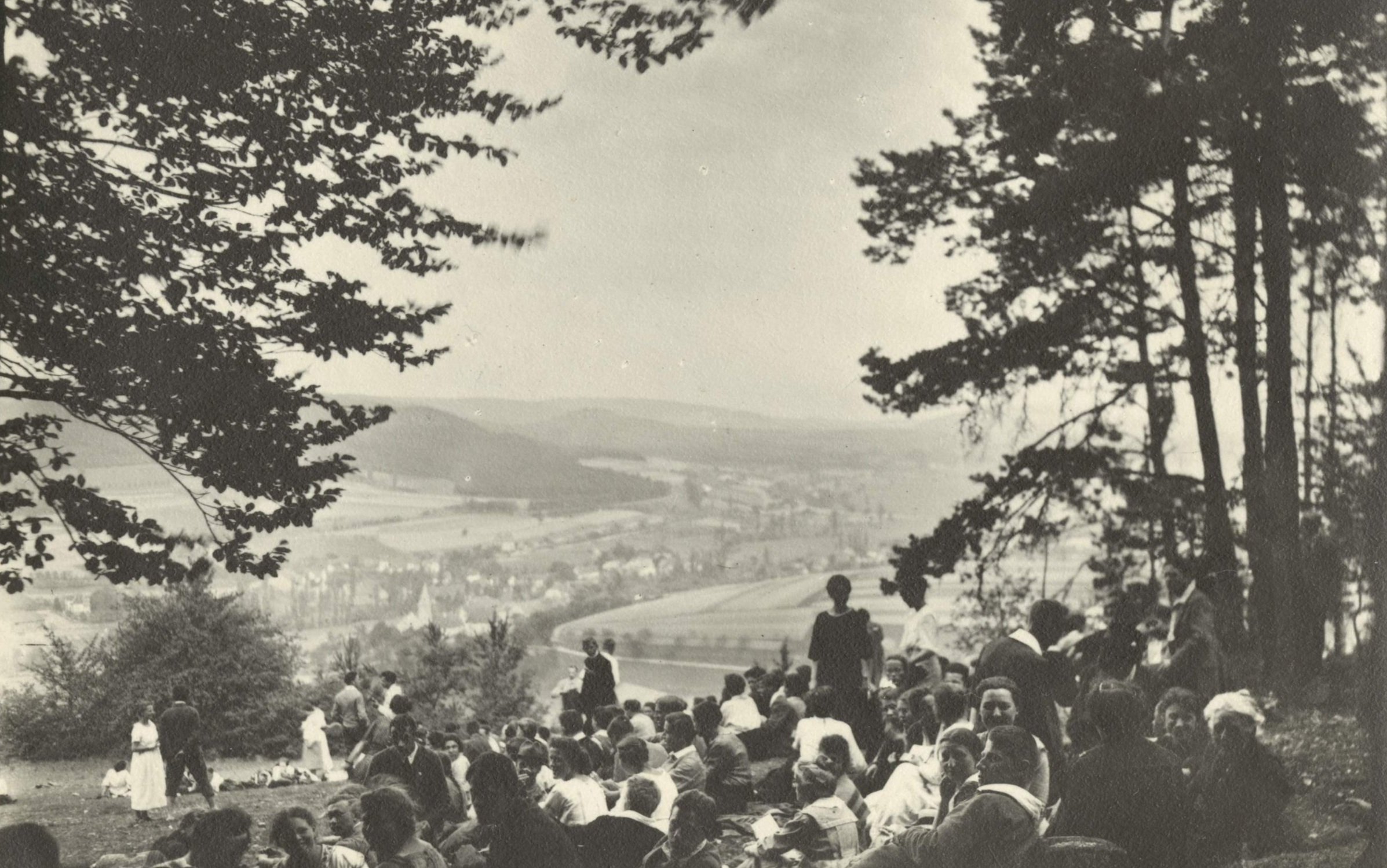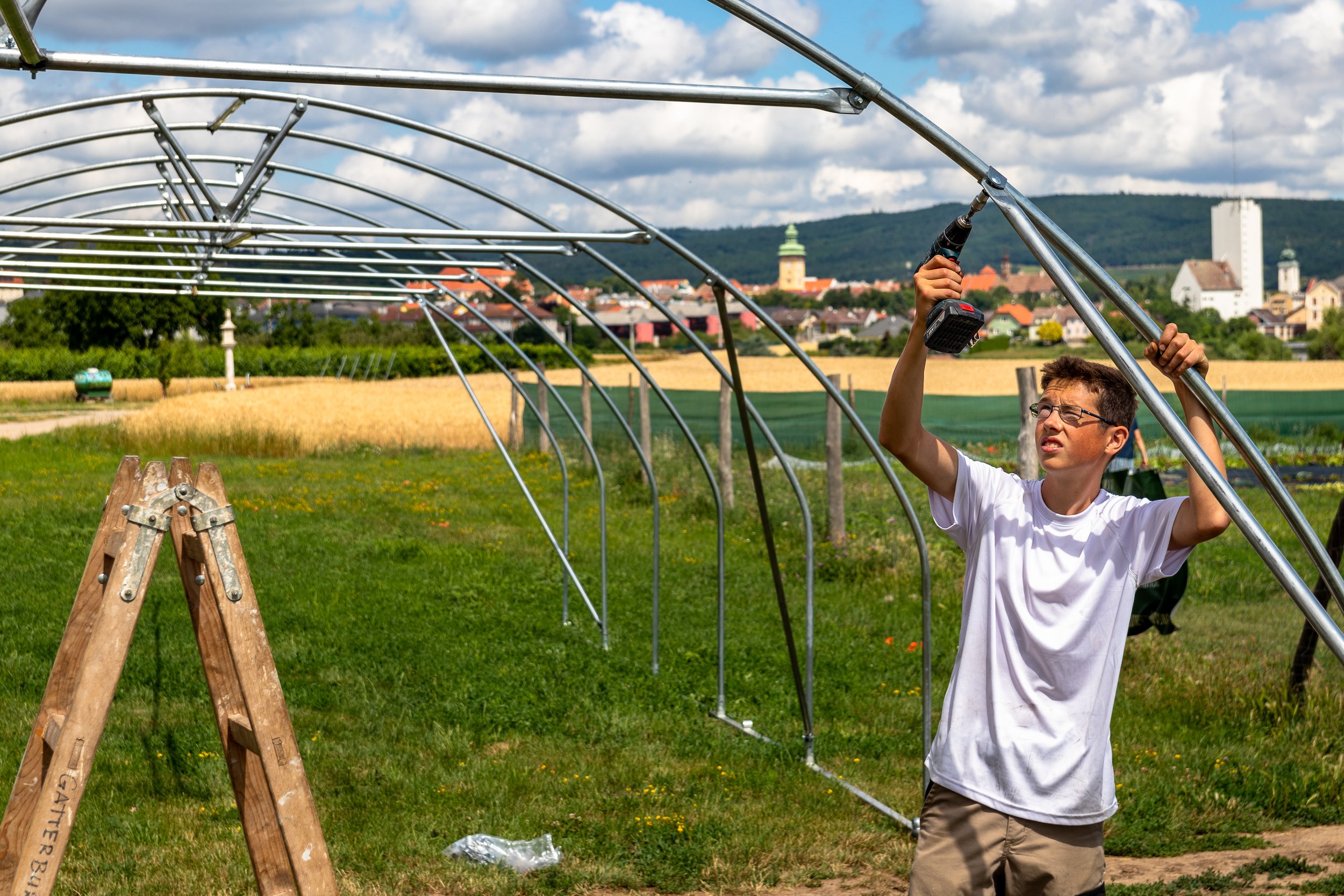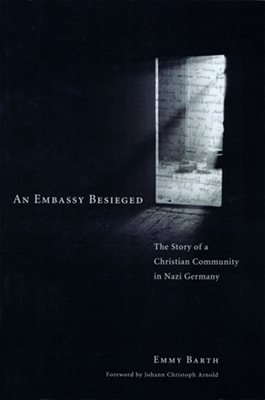
History of the Bruderhof
Founded over a century ago in the small German village of Sannerz, the Bruderhof has been shaped and propelled in part by the political and social events of the Western world. Despite inter-continental migrations and many challenges and changes, we recognize clearly God’s protection and guidance over the years since our beginnings in 1920. Click through the timeline below to see a historical overview of the Bruderhof, from its conception through to the present.
-
![Member of the Sannerz Bruderhof community]()
1920: SANNERZ BRUDERHOF STARTED
The Bruderhof was founded in 1920 in Germany by the Protestant theologian Eberhard Arnold, his wife Emmy, and her sister Else von Hollander. Seeking answers to the devastation of post-war society and frustrated by the silence of the established church in the face of widespread chaos, they left Berlin and moved to the remote village of Sannerz. There, inspired by the example of the first Christians in Jerusalem, they started a community with a small group of fellow Christians.
-
![Construction of a new building at the Rhon Bruderhof]()
1933: GROWTH, AND NAZI PERSECUTION
In its first years the Bruderhof quickly grew to over a hundred people and relied on farming and the sales of books from its own publishing house, known today as the Plough. Money was always scarce, in part because the community opened its doors to orphans, single mothers, and others in need of assistance. Poverty became more acute after 1933, when the Nazis banned the sale of books and crafts by the community.
-
![Brick making at the Cotswold Bruderhof]()
1936: A NEW START IN ENGLAND
A farm was purchased in the Cotswolds in England in 1936. This community was started as a mission post but also as a refuge should Nazi persecution force the community to flee.
-
![Early Bruderhof members]()
1937: BRUDERHOF IN GERMANY RAIDED BY THE GESTAPO
In 1937, Storm Troopers surrounded the community, imprisoned several members, and gave the rest forty-eight hours to leave Germany. As a Gestapo official wrote in an internal memo, the Bruderhof “represents a worldview totally opposed to National Socialism.” This worldview included the refusal to salute Hitler, serve in the military, or accept a Nazi schoolteacher.
-
![In Holland, after the three men who had been arrested were released from prison]()
1937: ESCAPE FROM GERMANY
The expelled members managed to find their way to Liechtenstein and Holland and then to England, where they joined their fellow community members at the Cotswold Bruderhof. The members who had been arrested managed to escape and eventually made it to England as well.
-
![Plough Publishing at the Cotswold Bruderhof]()
1938: NEW MEMBERS IN ENGLAND
The new community rapidly grew to 350 over the next years. Many people who had experienced the horrors of World War I and who wanted to totally dedicate their lives to a way of peace came to visit and later joined the Bruderhof. Others heard about it from Bruderhof members who travelled throughout England to meet interested people, as well as through its publications, including the Plough magazine.
-
![Collecting eggs from the egg run at the Oaksey Bruderhof in England Collecting eggs from the egg run at the Oaksey Bruderhof in England]()
1939: WORLD WAR II BEGINS
With the outbreak of war in 1939, the mix of German refugees and English members aroused suspicion in the locality, resulting in a boycott of the community’s farm. By 1940, the English government had begun to implement a policy of forcible internment of enemy aliens and the community soon found itself faced with a choice: accept internment of all German nationals, or leave the country as a group. Committed to staying together, Bruderhof members decided to seek refuge abroad.
-
![Cotswold to Paraguay Trans-Atlantic voyage on the Andalucía Star Cotswold to Paraguay Trans-Atlantic voyage on the Andalucía Star]()
1941: TRAVEL TO PARAGUAY
The only country willing to accept a multinational group of pacifists in wartime was Paraguay, which lay across the submarine-infested waters of the Atlantic. By the end of 1941, all members of the Bruderhof – except for three who remained in England to sell the Cotswold property – had safely relocated there, and set out to build community in the jungle.
-
![Building the Ibate community in Paraguay Building the Ibate community in Paraguay]()
1942: A HARD EXISTENCE
Life in Paraguay was difficult, with a harsh and unfamiliar climate, tropical diseases, and limited access to the wider world. Over the next twenty years, however, three Paraguayan locations were established, as well as a hospital that served the community and tens of thousands of indigenous Paraguayans.
-
![Wheathill Bruderhof]()
1942: WHEATHILL IN ENGLAND
Even as most members fled to South America, so many English pacifists felt called to join the Bruderhof that the three remaining members were tasked with purchasing a farm and founding a new community in Shropshire.
-
![Woodcrest Bruderhof]()
1954: WOODCREST COMMUNITY IN NEW YORK
After World War II, a wave of interest in communal living led dozens of young Americans to visit the Paraguayan communities. By the early 1950s many had joined, and in 1954 Woodcrest, the first North American Bruderhof, was founded in New York’s mid-Hudson Valley. Meanwhile, other communities had been founded in Europe as well. By 1962 the Paraguayan communities had closed and members had emigrated to the United States and Europe. The community supported itself making wooden toys for children which were sold as Community Playthings.
-
![Bruderhof members at the 1965 Selma to Montgomery march Bruderhof members at the 1965 Selma to Montgomery march]()
1965: INVOLVEMENT IN CIVIL RIGHTS MOVEMENT
In March of 1965, two Bruderhof members travelled to Alabama to attend the funeral of Jimmy Lee Jackson, a civil rights activist from Marion who was beaten to death by state troopers during a peaceful voting rights march. Several other groups from the Bruderhof travelled to the south over the next several weeks, including a group who participated in the Selma to Montgomery march.
-
![Darvell Bruderhof, 1971]()
1971: DARVELL COMMUNITY IN ENGLAND
In 1971, a new Bruderhof was founded in the UK with the mission, in part, to reach people in Europe who couldn't travel to the USA. The property, located near the historic town of Hastings, was previously a sanitarium for tuberculosis patients.
-
![Early Rifton Equipment manufacturing]()
1977: RIFTON EQUIPMENT
Rifton Equipment began as an offshoot of Community Playthings. When Bruderhof designers paid a neighborly visit to a Connecticut home for children with disabilities, a therapist asked if they could custom-build a chair for a resident. Today, Rifton produces a range of products for people with disabilities and distributes in the United States and internationally.
-
![Maple Ridge Bruderhof community building]()
1985: NEW COMMUNITIES IN THE UNITED STATES AND ENGLAND
Over the next years, the Bruderhof continued to grow and spread. Several new communities were started in the 1980s and 1990s, including Maple Ridge, Spring Valley, Platte Clove, Beech Grove, and Fox Hill. These were all larger settlements of several hundred people each.
-
![Danthonia Bruderhof in Australia]()
1999: BRUDERHOF IN AUSTRALIA
Danthonia, the first Australian community, opened in 1999. The property, located in northern New South Wales, was originally owned by a homesteading family who raised sheep and cattle. In 2005, a house community in the town of Armidale was started.
-
![Breaking the Cycle's speaking at a school]()
1999: BREAKING THE CYCLE
Following the Columbine High School shooting, Bruderhof elder Johann Christoph Arnold together with NYPD Detective Steven McDonald began speaking in high schools about the power of forgiveness. The Breaking the Cycle program has been presented in 800 schools and high schools in the United States as well as in Northern Ireland, Israel, England, and Rwanda.
-
![Sannerz Bruderhof - back in the original house!]()
2002: RETURN TO GERMANY
The year 2002 marked the Bruderhof’s return to its original home on the edge of the small village of Sannerz. Two years later, Holzland, located in former East Germany, was established.
-
![Urban community house in Camden, NJ]()
2003: CITY LIVING
In 2003, the first urban “Bruderhof house” in Camden, New Jersey, was opened in an effort to reach people in new areas. The house community model has since been replicated in New York, Albany, Pittsburgh, St. Petersburg (FL), London, and several other cities.
-
![Villa Primavera in Asuncion]()
2009: BACK TO PARAGUAY
In 2009, Villa Primavera, a small community in the city of Asunción, was started, marking the Bruderhof’s return to the country that welcomed us in the 1940s and ’50s.
-
![Students at the Mount Academy]()
2012: THE MOUNT ACADEMY
Located in a former Redemptorist Brothers’ seminary on the banks of the Hudson River, the Mount Academy, which opened its doors in 2012, is a New York State registered private high school that educates teens whose parents are Bruderhof members as well as students from the neighborhood and abroad.
-
![Plough Publishing office space in Walden, NY]()
2013: PLOUGH PUBLISHING MOVES TO WALDEN, NEW YORK
In 2013, Plough Publishing, the Bruderhof’s publishing imprint that has been producing books and magazines since the first years of community life, opened new offices at the Fox Hill community in Walden, NY.
-
![Am Stein Bruderhof]()
2019: BRUDERHOF IN AUSTRIA
Bruderhof members moved to Austria in 2019, and in 2021 a former convent located less than an hour from Vienna was purchased and is now home to around forty residents. The Bruderhof has been warmly welcomed to Austria in particular by church leaders including Cardinal Christoph Schönborn. Austria has important historical connections for the Bruderhof as the place where Anabaptists first began living in full community of goods in the early 16th century.
-
![Yeongwol Bruderhof]()
2022: YEONGWOL IN SOUTH KOREA
Following decades of visits from Koreans interested in living in community and many being accepted into membership, a small Bruderhof was started in South Korea consisting of three houses on a small plot of land about five hours east of Seoul.
Books about Bruderhof history































